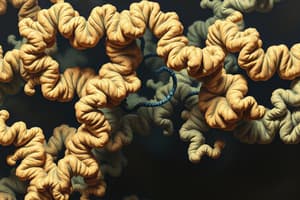Podcast
Questions and Answers
What percentage of the total weight do proteins account for in most cells?
What percentage of the total weight do proteins account for in most cells?
- 90%
- 25%
- 75%
- 50% (correct)
Which of the following is NOT a component of an amino acid?
Which of the following is NOT a component of an amino acid?
- An Amino group (-NH2)
- A hydrogen atom (H)
- A carbon
- A nitrogen group (N) (correct)
What is the basic structure of a protein?
What is the basic structure of a protein?
- A chain of fatty acids
- A chain of nucleotides
- A chain of amino acids (correct)
- A chain of monosaccharides
What determines the differences between protein monomers?
What determines the differences between protein monomers?
What percentage of the dry mass of most cells do proteins account for?
What percentage of the dry mass of most cells do proteins account for?
Which group in an amino acid varies among different amino acids?
Which group in an amino acid varies among different amino acids?
What is the role of proteins in cells?
What is the role of proteins in cells?
Which of the following is a polymer of amino acids?
Which of the following is a polymer of amino acids?
What is the 'R' group in an amino acid also known as?
What is the 'R' group in an amino acid also known as?
What type of group is the carboxyl group in an amino acid?
What type of group is the carboxyl group in an amino acid?
What is the variable group in an amino acid responsible for?
What is the variable group in an amino acid responsible for?
What is the function of proteins in cells?
What is the function of proteins in cells?
What are the types of Amino Acids?
What are the types of Amino Acids?
Define the following: Peptide:
Define the following: Peptide:
Define the primary structure of Protein.
Define the primary structure of Protein.
Explain the Secondary Structure of Protein.
Explain the Secondary Structure of Protein.
What is the Tertiary Structure of Protein?
What is the Tertiary Structure of Protein?
Outline the Quaternary Structure of Protein.
Outline the Quaternary Structure of Protein.
What is Denaturation?
What is Denaturation?
What Determines Protein Structure?
What Determines Protein Structure?
What are enzymes?
What are enzymes?
What is the function of most enzymes?
What is the function of most enzymes?
What is the common suffix for enzyme names?
What is the common suffix for enzyme names?
Proteins account for more than 50% of the dry mass of most cells.
Proteins account for more than 50% of the dry mass of most cells.
The basic structure of a protein is a chain of nucleotides.
The basic structure of a protein is a chain of nucleotides.
Amino acids have a carbon, a hydrogen atom, a carboxyl group, and an amino group.
Amino acids have a carbon, a hydrogen atom, a carboxyl group, and an amino group.
The 'R' group in an amino acid varies among different amino acids.
The 'R' group in an amino acid varies among different amino acids.
The 'R' group in an amino acid is also known as the carboxyl group.
The 'R' group in an amino acid is also known as the carboxyl group.
Enzymes are a type of large biological molecule.
Enzymes are a type of large biological molecule.
The function of most enzymes is to speed up chemical reactions.
The function of most enzymes is to speed up chemical reactions.
The variable group in an amino acid determines the differences between these protein monomers.
The variable group in an amino acid determines the differences between these protein monomers.
Peptide is a type of large biological molecule.
Peptide is a type of large biological molecule.
The quaternary structure of a protein refers to the sequence of amino acids.
The quaternary structure of a protein refers to the sequence of amino acids.
Denaturation is the alteration of a protein's shape, breaking the hydrogen bonds, and destroying the protein's function.
Denaturation is the alteration of a protein's shape, breaking the hydrogen bonds, and destroying the protein's function.
The common suffix for enzyme names is '-ase'.
The common suffix for enzyme names is '-ase'.
Peptide contains two or more amino acids, polypeptide contains ten or more amino acids, and if there are more than fifty amino acids, this is now considered a protein.
Peptide contains two or more amino acids, polypeptide contains ten or more amino acids, and if there are more than fifty amino acids, this is now considered a protein.
The primary structure of a protein is its unique sequence of amino acids.
The primary structure of a protein is its unique sequence of amino acids.
The coils and folds in the polypeptide chain result from hydrogen bonds between repeating constituents of the polypeptide backbone.
The coils and folds in the polypeptide chain result from hydrogen bonds between repeating constituents of the polypeptide backbone.
Tertiary structure is a protein’s geometric shape determined by interactions between R groups, rather than interactions between backbone constituents.
Tertiary structure is a protein’s geometric shape determined by interactions between R groups, rather than interactions between backbone constituents.
Quaternary structure results when two or more polypeptide chains form one macromolecule.
Quaternary structure results when two or more polypeptide chains form one macromolecule.
Alterations in pH, salt concentration, temperature, or other environmental factors can cause a protein to break, a loss of a protein’s native structure is called denaturation.
Alterations in pH, salt concentration, temperature, or other environmental factors can cause a protein to break, a loss of a protein’s native structure is called denaturation.
Enzymes are consumable and are a type of protein that acts as a catalyst to speed up chemical reactions.
Enzymes are consumable and are a type of protein that acts as a catalyst to speed up chemical reactions.
Enzyme names commonly end with the suffix 'ase'.
Enzyme names commonly end with the suffix 'ase'.
Proteins account for approximately 80% of the dry mass of most cells.
Proteins account for approximately 80% of the dry mass of most cells.
The secondary structure of a protein is determined by interactions among various side chains (R groups).
The secondary structure of a protein is determined by interactions among various side chains (R groups).
The quaternary structure of a protein consists of a fibrous protein consisting of three polypeptides coiled like a rope.
The quaternary structure of a protein consists of a fibrous protein consisting of three polypeptides coiled like a rope.
Denatured protein is biologically inactive.
Denatured protein is biologically inactive.
Match the following components with their roles in protein structure:
Match the following components with their roles in protein structure:
Match the following protein structures with their definitions:
Match the following protein structures with their definitions:
Match the following protein functions with their descriptions:
Match the following protein functions with their descriptions:
Match the following types of Amino Acids with their classification:
Match the following types of Amino Acids with their classification:
Match the following protein structures with their descriptions:
Match the following protein structures with their descriptions:
Match the following protein structure components with their interactions:
Match the following protein structure components with their interactions:
Match the following protein structures with their examples:
Match the following protein structures with their examples:
Match the following protein structure conditions with their effects:
Match the following protein structure conditions with their effects:
Match the following enzyme characteristics with their descriptions:
Match the following enzyme characteristics with their descriptions:
Flashcards are hidden until you start studying
Study Notes
Protein Composition in Cells
- Proteins account for approximately 80% of the dry mass of most cells.
- More than 50% of the dry mass of most cells is made up of proteins.
Structure of Proteins
- The basic structure of a protein consists of a chain of amino acids, not nucleotides.
- Amino acids are made of carbon, hydrogen, a carboxyl group, and an amino group.
- The 'R' group in an amino acid varies among different amino acids and determines their unique properties; it is also referred to as the variable group.
Types of Protein Structures
- Primary Structure: Unique sequence of amino acids in a polypeptide chain.
- Secondary Structure: Formed by hydrogen bonds between parts of the polypeptide backbone, resulting in coils and folds.
- Tertiary Structure: The overall 3D shape of the protein, determined by interactions between R groups.
- Quaternary Structure: Occurs when two or more polypeptide chains combine to form a functional protein; e.g., fibrous proteins can consist of multiple coiled polypeptides.
Protein Functions
- Proteins serve various roles in cells, including catalyzing biochemical reactions.
- Enzymes are proteins that speed up chemical reactions and typically end with the suffix '-ase'.
- Denaturation refers to the alteration of a protein's shape, leading to the loss of function, often due to environmental factors like pH and temperature.
Types of Amino Acids
- Amino acids can be classified based on their side chains (R groups), influencing their properties and roles in protein formation.
Peptides and Polypeptides
- A peptide is a chain of two or more amino acids, while a polypeptide consists of ten or more amino acids. A protein is defined as a polypeptide with more than fifty amino acids.
Enzyme Characteristics
- Enzymes are large biological molecules that facilitate chemical reactions without being consumed in the process.
Studying That Suits You
Use AI to generate personalized quizzes and flashcards to suit your learning preferences.





